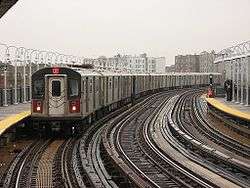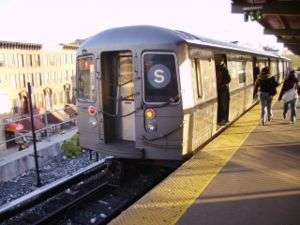Flivver Lo-V (New York City Subway car)
| Flivver Lo-V | |
|---|---|
| Manufacturer | Pullman Company |
| Replaced | 1962 |
| Constructed | 1915 |
| Refurbishment | 1955-1958 |
| Number built | 178 |
| Number preserved | 0 |
| Number scrapped |
178 (124 motors, 54 trailers) |
| Fleet numbers |
4037-4160 (motors) 4161-4214 (trailers) |
| Capacity | 196: 44 (seated) 152 (standing) |
| Operator(s) |
Interborough Rapid Transit Company New York City Transit Authority |
| Specifications | |
| Car body construction | Steel |
| Car length | 51 ft 0.5 in (15.56 m) |
| Width | 8 ft 10 in (2,692 mm) |
| Height | 11 ft 10.5 in (3,620 mm) |
| Floor height | 3 ft 2 1⁄8 in (0.97 m) |
| Doors | 6 |
| Maximum speed | 60 mph (97 km/h) |
| Weight |
Motor car: 77,700 lb (35,200 kg) Trailer car: 55,600 lb (25,200 kg) |
| Traction system |
Motor car: GE PC8 or PC10 using Westinghouse 300 or GE 212 motors (200 hp each). Two motors per car (both on motor truck, trailer truck not motorized). Trailer car: None Air Compressor: WABCO D-2-F |
| Power output | 200 hp (149 kW) per traction motor |
| Electric system(s) | 600 V DC Third rail |
| Current collection method | Top running Contact shoe |
| Braking system(s) | WABCO Schedule AMRE with R type triple valve, ME-21 brake stand, and simplex tread brake rigging |
| Coupling system | WABCO F |
| Headlight type | Kerosene light |
| Track gauge | 4 ft 8 1⁄2 in (1,435 mm) |
The Flivver Lo-V, a New York City Subway car type, was built in 1915 for the IRT and its successors, which included the New York City Board of Transportation and the New York City Transit Authority. The name Flivver originates from a slang term of the same name used during the early part of the 20th century to refer to any small car that gave a rough ride.
Service history
Initially, the Flivvers ran on the original IRT mainline express, which utilized the modern day IRT Broadway – Seventh Avenue Line north of 42nd Street on Broadway and Seventh Avenue, the modern day 42nd Street Shuttle, and the modern day IRT Lexington Avenue Line south of 42nd Street on Park Avenue South. Following the 1918 IRT expansion into the modern "H" system that serves Manhattan's East and West sides separately with the 42nd Street Shuttle connecting them, the Flivvers ran primarily on the Seventh Avenue Express (today served by the 2 route). Later, beginning in the 1950s, the cars also ran on the East Side lines, providing express service on Lexington Avenue to both the Jerome Avenue and White Plains Road branches (served today by the 4 and 5 routes respectively). The last Flivver to run in service ran on the Lexington-White Plains Road Express in 1962, and was removed from service at that time.[1]
No Flivver cars have been preserved. All were scrapped following their removal from revenue service.
Description
Flivver Lo-Vs were arranged in mixed trains consisting of trailers and motor cars. While trailer cars were equipped with brakes, but no air compressors or motors, motor cars were equipped with all three. The Flivvers were part of the first generation of Lo-V subway cars, along with the first Steinways. Flivvers utilized parts from the IRT Composites, which were being modified at the time to provide service on the IRT's Manhattan and Bronx elevated lines beginning in 1916.
The interior and exterior of a Flivver Lo-V was similar to the rest of the IRT fleet that predated it. Individual, square rattan seats were arranged in a longitudinal seating pattern along the side walls of the car. Three doors on each side - two at the end vestibules and one in the center - provided for entrance and exit from the car. Incandescent lighting was used, and paddle ceiling fans cooled the car. Clerestory style vents in the upper roof opened for additional airflow. The carbody was made entirely of steel, with drop sash windows running down the sides of the car. The cars used metal signage displayed in the side windows of the car to indicate destinations and route. Kerosene lamps were displayed on the ends of trains as running lights - white for the front of the train and red for the rear.
"Lo-V" is short for "Low Voltage" which refers to the cars' form of propulsion control. Earlier Composite and "Hi-V" (High Voltage) equipment that ran on the IRT utilized a 600 volt DC circuit that ran directly through the motorman's master controller to control the car's propulsion. The 600 volts was also trainlined through the whole train by the use of high voltage jumper cables. However, Lo-V equipment used trainlined battery voltage (32 volts) in the motor control circuit to move high voltage (600 volt) contacts underneath each car, which would control the car's propulsion. This tremendously improved the safety of the equipment for both train crews and shop personnel alike.
Flivver Lo-V's maintained the older braking system of the High Voltage equipment. The older setup, known as AMRE, featured different notches on the brake stand for the motorman depending on if he was operating his brakes with electric control (which synchronized the brakes on all cars of the train electrically) or if he was operating pneumatically (which did not synchronize the brakes, and took longer to react). The newer setup, to be known as AMUE, came on the Steinways and Standard Lo-Vs, but never on the Flivvers. AMUE brake stands would utilize the same notch to apply brakes regardless of whether or not the electric brake was active. However, the Flivvers maintained the older AMRE setup, which had also been used on many of the Hi-V cars. They were the only car with Low Voltage propulsion to use the AMRE setup.
Because the Low Voltage Propulsion system was not compatible with earlier High Voltage equipment, the Flivvers could not run with those cars. Because the Flivver AMRE braking setup was not compatible with the other Low Voltage equipment, the Flivvers could not run with those cars either. Therefore, they could only run amongst themselves. Further, they were found to perform better in certain specific combinations than in others, and so they were left to run in these "optimal" configurations. When arranged in less than optimal configurations, the cars often gave a very rough ride with a lot of bucking. In optimal configurations they were respectable performers. Many IRT crews commented about the speed of these cars, even noting that at the end of their service lives, they were still significantly faster than the other equipment running. This was because, towards the end of their operation, trailers cars were eliminated and the Flivvers operated in trains of all motor cars. Historians hypothesize that their speed was a large reason why they were typically assigned to express services throughout their lifetimes.
See also
- Steinway Lo-V, a low voltage propulsion control IRT subway car built from 1915 to 1925.
- Standard Lo-V, a low voltage propulsion control IRT subway car built from 1916 to 1925.
- World's Fair Lo-V, a low voltage propulsion control IRT subway car built in 1938.
References
- ↑ Gene Sansone, New York Subways: An Illustrated History of New York City's Transit Cars, ISBN 0-8018-7922-1, pp. 74 - 77
External links
| Wikimedia Commons has media related to Lo-V (New York City Subway car). |


